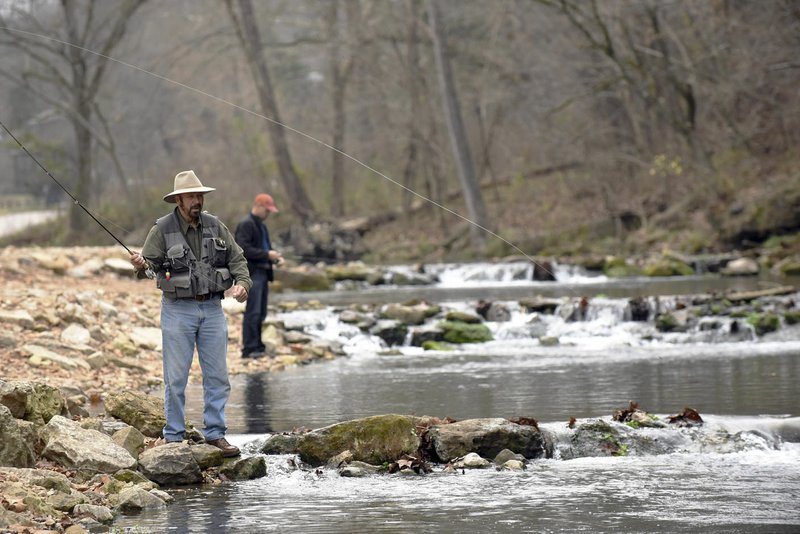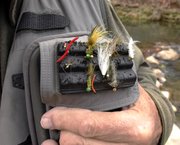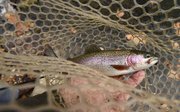CASSVILLE, Mo. -- Catch and release season at Roaring River State Park offers more than one way to catch trout.
Rainbow trout had rods quivering recently for three fishermen along Roaring River, the free-flowing centerpiece of the park. Each angler used a different tactic to get fish to bite.
What is a fly?
Regulations at Roaring River State Park say a fly “is an artificial lure constructed on a single-point hook, using any material except soft plastic bait and natural and scented bait that is tied, glued or otherwise permanently attached. Flies may be fished with or without a spinner.”
— Source: Missouri Conservation Department
Trout get a new lease on life every time they're caught. Fishermen may catch fish all day during catch and release season, but they've got to throw them all back.
Catch and release fishing is allowed from 8 a.m. to 4 p.m. Friday through Monday from the second Friday in November until the second Monday in February. Only flies may be used, but a marabou jig is considered a fly by rule.
Anglers need a Missouri fishing license and annual trout permit to fish. Daily tags aren't sold during catch and release season.
The park's catch and keep season runs March 1 through Oct. 31.
Floyd Redburn was one of five anglers in the park when fishing started at 8 a.m. on Nov. 17, an overcast Friday. He tried for trout like most anglers do, with a fly rod and fly that sinks deep.
Redburn snapped his wrists to form artful loops of yellow fly line while gripping the rod's cork handle. A length of thin 6X leader -- about 3.5-pound test -- was attached to the fly line. He'd knotted a black woolly bugger fly to the leader.
A conga line of rainbow trout danced at his feet the first hour of fishing, including a dandy 16-incher that splashed into Redburn's wood-handled net. With a gentle hand he released the fish.
"I'm catching them on this woolly bugger today. Some days they'll only hit one thing, so it's good to experiment," Redburn said. Pheasant tails and nymphs are other flies he likes to throw.
All these flies sink -- wet flies, they're called -- and are what most fishermen use at Roaring River. Sometimes Redburn gives them some action with little jerks of his fly line. Other times, he dead-drifts them, letting them drift naturally in the current.
Redburn started his day in the middle section of the trout stream. "By the end of the day I'll fish the whole river," he said.
Roaring River Spring gives birth to the waterway. The spring is the 20th largest in Missouri with 20 million gallons of clear, cold water bubbling to the surface daily.
The stream twists and tumbles about 1.5-miles through the park, then on to Table Rock Lake five more miles downstream. Trout can be caught along its entire length during winter, but most anglers fish in the park.
Only flies are allowed, but they can be cast with any type of rod. Spinning rods and reels are perfectly fine. That's how Mike Zebert of Pierce City, Mo., fished his tiny marabou jig.
"This time of year I'm a jig man," he said. Shades of brown or gray are his favorite colors.
Zebert used a one-sixty-fourth-ounce jig on 4-pound-test line. The light-weight jig casts far enough, "but I can't really reach the other side of the river with it," he said.
Trout aren't the only reason he visits the park in the off season.
"What I like best is the quiet," Zebert said. "My wife and I are camping here this weekend. I'll fish for awhile then we'll go hike some of the trails."
Rogers Thomas used a third tactic farther upriver. He fished with a dry fly, one that floats on the surface. It's rare to see a Roaring River angler lob a dry fly.
Not only that, Thomas fished with a hand-made bamboo fly rod made by a man who lives near the park. The rods are pricey, about $1,200 a pop.
"And I own eight of them," said Thomas, of Eagle Rock, Mo.
The dry fly appeared as a mere speck when he clasped it between his thumb and forefinger, showing it to a visitor.
"This is a black pearl Gulpin, size 22," he said. Size 22 is teensy weensy in the fly fishing world.
Thomas said it works because few anglers use dry flies. Trout aren't used to seeing them.
He casts the fly to the far bank where he gets most of his strikes.
"Only thing is, big fish won't come up for it," he said.
Most of the fish he caught that day were in the 12-inch range. That's about average for a Roaring River rainbow trout, said Brad Farwell, assistant manager at the Roaring River trout hatchery. The hatchery provides all the trout stocked at the park. There's no natural trout reproduction.
Missouri Conservation Department operates the hatchery. Missouri State Parks runs the park.
"A couple days before catch and release season started, we stocked 1,100 trout that average 12.5-inches long. We also stocked 20 lunkers about 3 pounds each. Every few weeks we'll put in a few more fish," Farwell said.
As Roaring River anglers showed, there's more than one way to catch them.
Flip Putthoff can be reached at [email protected] or on Twitter @NWAFlip
Sports on 11/28/2017



